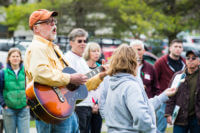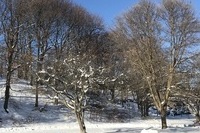Practical Info for Tree Planting and Care

We want to make it easy for you to plant trees
You can do it! And we don’t want the logistics to stop you. This practical guide to selecting, planting, and nurturing trees will give you a great start, and your tree will thrive through a long and beautiful life.
CHOOSE THE RIGHT LOCATION
Where will your tree(s) provide the most benefit?
Large-growing shade trees provide many benefits wherever you plant them. To cool your house and save on air conditioning, planting them to the southwest of your house is most effective, with south or west excellent choices as well. To minimize urban pollution runoff entering our streams and lakes, plant where the canopies will spread over paved areas. In residential settings, conifers function best as winter windbreaks, placed to the north or northwest of your house. Under wires, plant small ornamental trees.
Distance from structures
Your tree will grow larger than you might imagine. It is best to plant shade trees 15 or so feet from any multi-story house, even though the canopy of shade trees can be shaped by early pruning to avoid the house. If you have a ranch or other 1-story house, the shade tree should be 10 feet from the house. Plant conifers 20 or so feet away from a structure, since they grow widest at their base, and their lower branches are what provide the energy-saving wind protection.
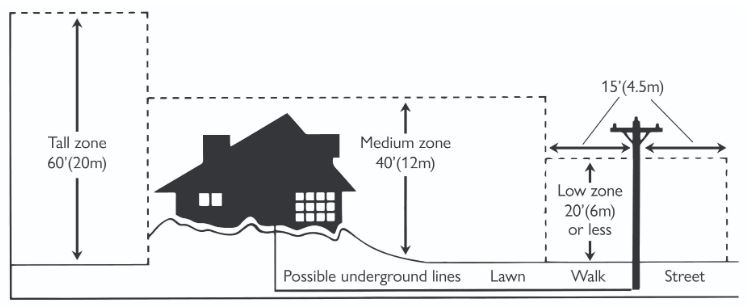
BUY YOUR TREE
Species recommendations
To maximize the benefits and the resilience of our urban forest, the strategy is to plant (1) diverse species, (2) native species, and (3) wherever space allows, large-growing species.
Our recommended shade tree species include: Basswood, Hackberry, American Sycamore, Tulip, Yellowwood, Black Cherry, Kentucky Coffeetree, American Elm, Thornless Honeylocust, Black Tupelo, various native Oaks (White, Swamp White, Northern Red, Bur, Chestnut, Scarlet, Chinkapin, and Pin), River Birch, native Maples (Sugar, Red, and Silver), and Black Walnut. Download our list of recommended trees and where to buy them.
Size and form
Trees come from nurseries in three basic packaging forms: bare root, ball & burlap, and in containers. Most local nurseries sell trees in containers. You may be able to purchase bare root trees from online nurseries. They are usually shipped dormant, in time for spring planting. If you are looking for a larger (older and more expensive) tree, it will probably come in ball & burlap. Paying more for a bigger trees is not necessarily better. Click here to read more.
PLANT YOUR TREE
When to plant
Late April or May, when nature generally provides both rain and cool weather, is the ideal time to get your young tree started. Late September or October can work as well. Only plant in the summer if you are committed to intensive watering to get your tree through the long hot days.
How to plant
The survival of your tree depends on proper planting. We have put together detailed planting instructions, whether you bought a seedling, a container/potted tree, a bare root tree, or a ball-and-burlap tree. But the basic planting principles can be summarized as:
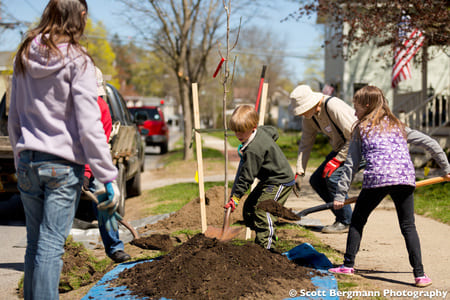 Dig a wider hole than you probably think is necessary
Dig a wider hole than you probably think is necessary- Get the hole depth right, so that the “root flares” (explained below) are visible just above the soil
It is good, but not essential, to improve the soil by mixing compost into the hole. And, of course, don’t pile mulch against the trunk (see mulching below).
Some handy planting guides
BARE ROOT TREES: Bare Root Planting Guide (detailed) and Planter Cheat Sheet (Key Tips)
BALLED & BURLAP TREES: Ball & Burlap Planting Guide (detailed)
How to mulch a tree to avoid deadly Mulch Volcanoes
CARE FOR YOUR TREE
Water
Regular, generous watering of your young tree is critical to its survival. Transplanting is a traumatic stress for a tree, so give it plenty of water, especially during its first weeks and throughout its first season. We recommend at least 5 gallons two or three times a week. (No need to water if nature has been providing steady, soaking rains.) Use a slow flow from a hose, or gallon jugs, or buy a tree gaiter that you fill for slow release into the roots.
Mulch
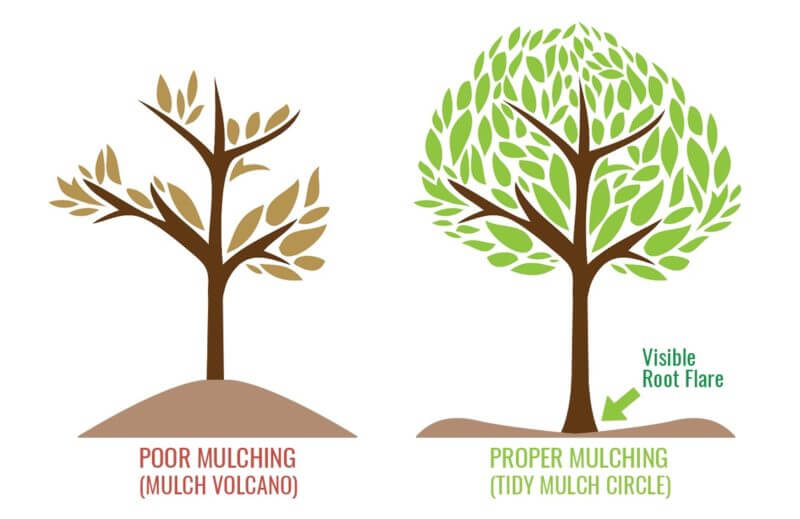
Mulch helps a tree retain moisture around the roots, but excessive mulch can kill trees. Keep mulch away from the trunk and never pile it up in “mulch volcanoes,” those mounds of mulch that are such a harmful fad. The 3-3-3 rule is a good guide: mulch should be 3 inches deep, spread in a circle with a 3-foot radius, and kept at least 3” from the trunk.
Prune
Pruning while your tree is young and its branches are small is the best way to shape the tree of your dreams.
First season. Don’t prune much during the first season. Trim off dead or injured branches, but otherwise, let your tree get established.
During the next few years, gradually shape your tree with two goals in mind:
- Establishing a single good vertical “leader” as the main trunk, and
- Gradually cutting back and eliminating lower branches, until you establish what you want to be the lowest permanent branches.
Lowest permanent branches may be a tough idea to wrap your head around as you look at your young tree. But if you look at mature shade trees that you admire, you will notice that their lowest branches are probably 12-20 feet off the ground. Now look again at your young tree. Quite likely, very few, and possibly none, of the current branches on your small shade tree sapling are high enough to be permanent. Never trim off more than about 25% of your tree’s canopy in any one season.
TROUBLESHOOTING TREE PROBLEMS
Something is eating the leaves on my trees
Our area has been experiencing a significant infestation of spongy moth (formerly called gypsy moth). See our FAQ for info on spongy moth and what homeowners can do.
And check out our fun tree planting song




